|
25th March
Barns Ness and Dunbar Harbour
At last, it happened - a dry,
sunny Sunday throughout the whole of Scotland! We had our choice of a
full range of our favoured destinations. There was a report of an
American White-winged Scoter off the Musselburgh coast but I decided
that it would be so far out it would be a unlikely we’d get any decent
shots. So after our usual excellent Dalkeith Morrisons breakfast
(9.5/10) we zoomed down the A1 to Barns Ness, east of Dunbar, a place
that’s always very kind to us. The tide was well out as we
arrived and as we walked along the rocky shoreline we immediately got
shots of a foraging Oystercatcher, the usual and ever-giving Rock
Pipits moving amid the piles of insect-rich seaweed and beyond and a
pair of male Shelducks sailing in the blue rock pools. We moved around
the lighthouse and down the grassy path that runs parallel to the
beach. Over the fields to our right we heard hovering Skylarks singing
their hearts out. As luck would have it, one of them descended onto a
fence post very close to us, so I of course, took its picture.
Oystercatcher
|
Rock Pipit
|
Shelduck
|
Skylark
|
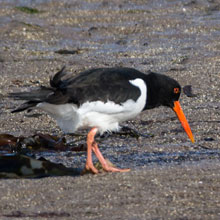
|
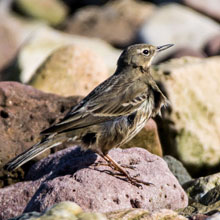
|
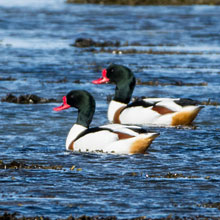
|
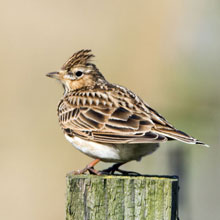
|
We had spotted bird activity
around a large pile of seaweed on the beach so we continued on the path
to enter the beach through the dunes to the east of the seaweed, as the
sun would have been behind us, enabling better lit pictures of the
birds there. On the way we came across a Meadow Pipit pausing a few
moments on the fence, long enough to get a snap. On the beach I settled
down at the seaweed on my trusty 3-legged stool and waited for the
birds to fly in - and fly in they did. After only 30 minutes I had
observed and captured images of Rock Pipits, Pied Wagtails and even
Reed Buntings.
Meadow Pipit
|
Rock Pipit
|
Pied Wagtail
|
Reed Bunting
|
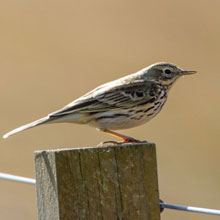
|
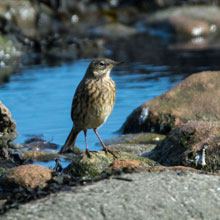
|
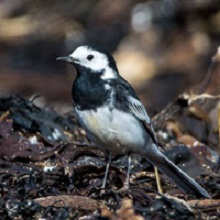
|
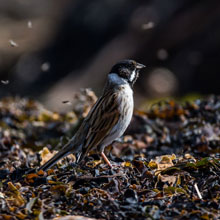
|
The feeding must have been really
good for them as they didn’t seem to be bothered by our presence. The
one exception were the Starlings. Occasionally a flock of Starlings
would fly in only to swoop away when they saw us. Reed Buntings and the
quite similar looking Skylarks flew past us and just got stuck in. I
got a glimpse of a female Reed Bunting on a rock and also a distant
Stonechat caught my eye as it picked its way through the seaweed.
Meadow Pipit
|
Skylark
|
Female Reed Bunting
|
Stonechat
|
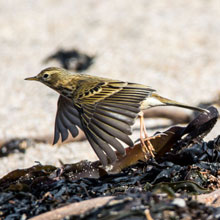
|
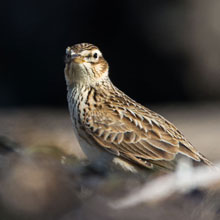
|
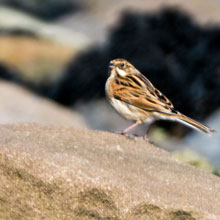
|
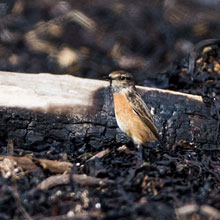
|
There came a point though when the
Starlings overcame their reticence and started to occupy the seaweed.
John was first to spot the huge cloud of birds as they few in from
distant rocks. One particular bird settled fairly close, and of course
I took its picture. When we decided to move on I just missed a small
group of waders, probably Dunlin, that had been probing around some
rocky pools adjacent to where I had been sitting. I did though get
pictures of a nodding Redshank. We left the beach and moved across the
fenced-off field to the trees to the south of the area. We looked over
the stone wall into the field beyond where we just managed a decent
shot of a retreating Brown Hare, the first I’d seen there.
I had a good look for any others
Hares, as often they gather in groups, but to no avail. I did though
manage a picture of a wee Rabbit which was sitting just over the wall.
As we walked back to the car a Song Thrush was loitering in the grass
below a small bush. Close by a Magpie was showing off how the sunlight
drew colours from the feathers on its wings and long tail. We drove out
of the Barns Ness car park along the single carriageway road
approaching Whitesands when John suddenly implored me to stop the car
as he had spotted a Kestrel hovering very close to the road. I obliged
and fired off some shots of the bonny bird. Apologies to the driver I
obstructed as I did so!
European Rabbit
|
Song Thrush
|
Magpie
|
Kestrel
|
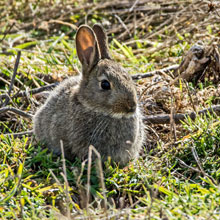
|
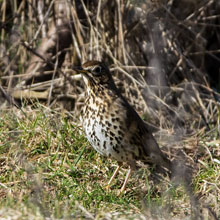
|
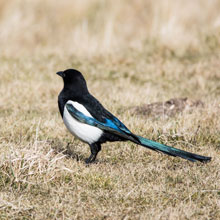
|
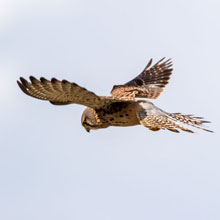
|
At Dunbar we parked at our usual
spot by the Castle overlooking the Harbour. I was delighted to spot a
handsome Pied Wagtail on a rock literally beside the car, so I took its
picture. As we alighted from the car we were met by the calls of the
birds on the walls of the Castle ruins, “kitt-e-wake, kitt-e-wake”.
Unsurprisingly they were Kittiwakes! In the harbour a few very
beautiful Eider were circulating. Occasionally a lone Grey Seal bobbed
up briefly to check if the fishing boats were discarding any scraps of
fish. My last shot of the day was of a Herring Gull with a beakful of
crab, spotted by John’s eagle eyes (see Pictures of the Week, below).
Pied Wagtail
|
Kittiwake
|
Eider
|
Grey Seal
|
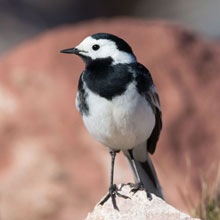
|
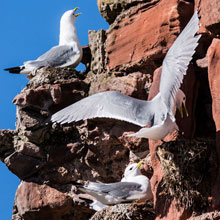
|
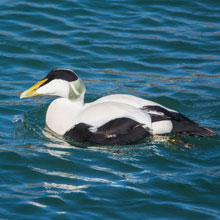
|
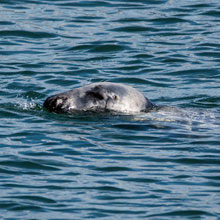
|
So it’s was then just a matter of
polishing off a pair of Custard and Almond Danish pastries washed down
with some strong tea. We got more than a few good shots justifying my
choice of destination. I’ll probably check out the Yanky Scoter through
the week though .
Pictures of the Week
Skylark
|
Kestrel
|
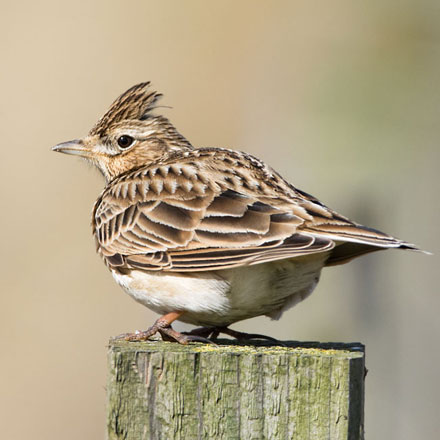
|
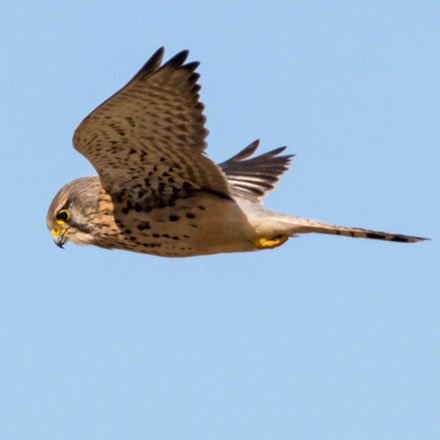
|
Herring Gull
|
Pied Wagtail
|
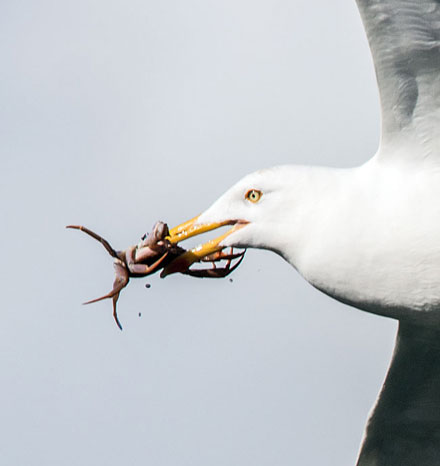
|
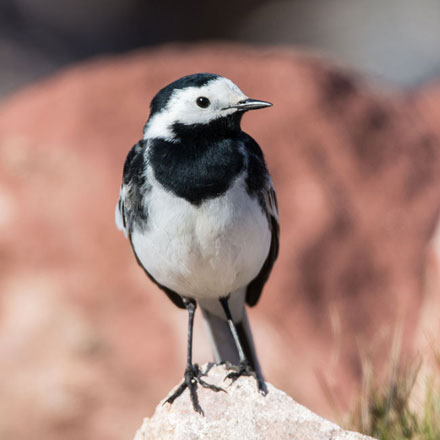
|
18th March 2018
Stevenston Point, Saltcoats and Irvine Harbour
I’m glad to report that for
Sunday’s trip I was rejoined by John following his 3-week absence. With
the prospect of a bit of better weather, in the West at least, than
I’ve experienced in recent weeks, I was optimistic of a successful
outing. We agreed to return to one of our favourite areas encompassing
Saltcoats, Stevenston and Irvine. Our breakfasts in Stevenston
Morrisons were first rate. John rated his double eggs on toast as
10/10, but I lopped a half mark off my “Wee Scottish” due to what I
term “asymmetrically-sliced” buttered toast - impossible to construct a
correctly aligned toast sandwich of beans and sausage (sad, I know)! At Stevenston Point we got the
ball rolling with a 1st winter Herring Gull showing its emerging adult
plumage. On the north side, a group of around 5 Red-breasted Mergansers
were showing courting behaviour in between diving for food. Nearby a
Great Black-back Gull swooped impressively leading our eyes to a
previously unnoticed flock of Purple Sandpipers on the old pier. As the
tide came in they moved to rocks by the shore.
Herring Gull
|
Red - breasted Merganser
|
Greater Black - backed Gull
|
Purple Sandpiper
|
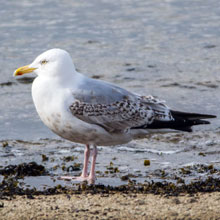
|
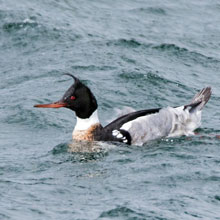
|
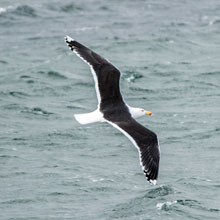
|
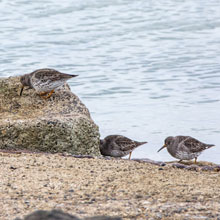 |
A pair of Sanderling were
displaced by the Purple Sandpipers, but not so the few Dunlin that
stubbornly held their ground. A Redshank snoozed through all the
commotion, but some Turnstones showed from their rocky crevices as the
Sandpiper invasion continued.
Things settled down after that
series of sightings so we moved North to Saltcoats harbour. A juvenile
Herring Gull was sitting on the seawall by the car park, unconcerned by
passing pedestrians. As I snapped the gull John spotted a solitary
Black Guillimot a the start of the harbour. We moved round to get a
better picture and on the way came across a beautiful adult Herring
Gull, obviously as used to people as its junior earlier and posed for
its picture. The Black Guillimot was spooked by a chap who had driven
his car onto the harbour and started photographing it. I turned my
attentions to the harbour waters where three drake Eiders were trailing
behind a female, however she quickly lured them out of sight behind
some rocks.
1st Cycle Herring Gull
|
Black Guillemot
|
Herring Gull
|
Eider
|
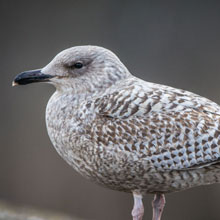
|
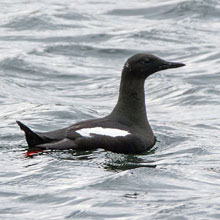
|
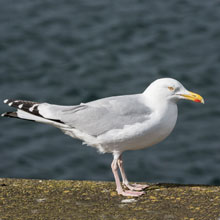
|
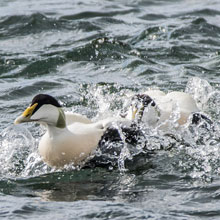
|
On the rocks just north of the
Harbour we came across more Purple Sandpipers with Turnstones. They
were sheltering from the the now very stiff and bitter East wind. John
spotted another group of courting Red-breasted Mergansers as they moved
south into the Harbour. Occasionally the over-vigorous attentions of
the males caused the female to take flight eagerly pursued by the males
who weren’t going to be shaken off so easily.
As we moved back to the car,
passing sheltering Oystercatchers and Redshanks, we met the courting
Eiders who were now very close to the sea wall. The males were raising
their heads and calling “a-woo, a-woo”. The female seemed unimpressed.
The Red-breasted Mergansers were also present, their males similarly
wooing the female, but with more frantic posturing and screeching calls.
We drove to Irvine Harbour for our
tea. We had a quick scan for anything we could see along the harbour
mouth. Just as we thought all the birds had gone home, I spotted a
Stonechat on the seashore (see Pictures of the Week, below). Back in
the warm car, as we chomped our way through our caramel and custard
lattice Danish pastry washed down with well-brewed tea, we reflected on
what we’d seen. We had been frustrated a bit by the sunny intervals
being out of phase with our bird observations - sun, no birds, then
birds, no sun! However it was good to have someone, other than myself,
to complain to!
Pictures of the Week
1st Cycle Herring Gull
|
Eider
|
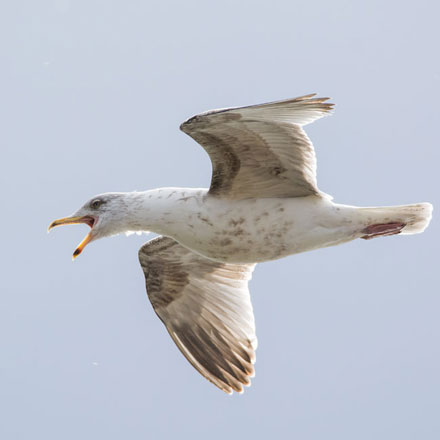
|
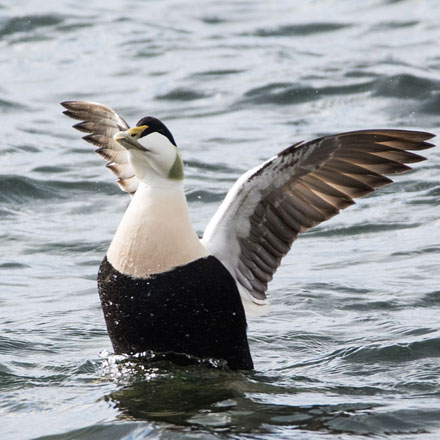
|
Red - breasted Merganser
|
Stonechat
|
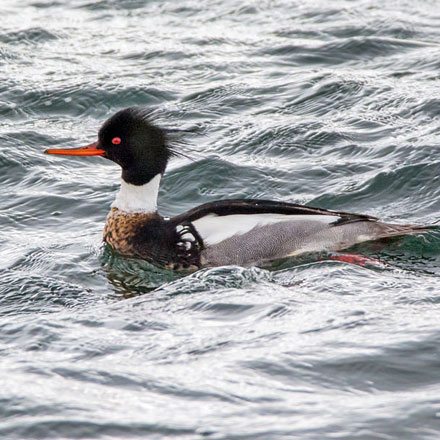
|
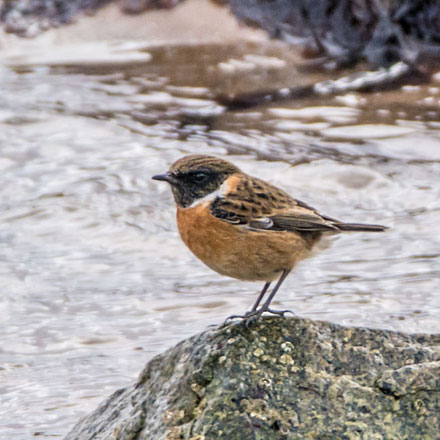
|
11th March 2018
Maidens and Doonfoot
It was a foggy start to the day,
but skies were to clear from the south-west by the afternoon so I
headed SW to Maidens (John was unfortunately indisposed for a third
week) and, after a breakfast pit stop into Stewartfield Morrisons in
East Kilbride (9/10), I moved carefully through the fog onto the M77
south to Ayr. I then took a right through Alloway, Robert Burns’ home
village, to the A719 coast road which lead to Maidens. On arrival I was
a bit disappointed to find the skies were leaden and, to make matters
worse, the tide was well out and the area was overrun with dog walkers,
so I decided it would be a quick visit as the light was better in Ayr.
I walked out to the north side of the Harbour mouth where I found a
Mute Swan and a Common Gull. On the rocks a pair of Pied Wagtails were
darting about as if they were going through some courtship behaviour.
As I scanned the rocks on the south side of the harbour mouth I noticed
a solitary Glaucous Gull. I believe from its plumage it was a 1st cycle juvenile.
Mute Swan
|
Common Gull
|
Pied Wagtail
|
1st Cycle Glaucous Gull
|
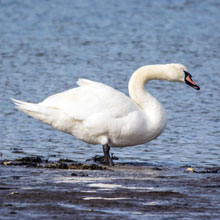
|
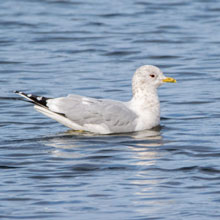
|
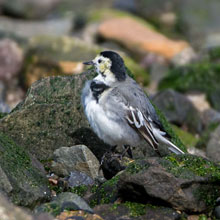
|
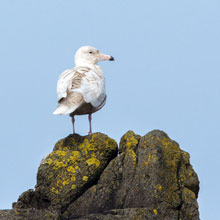
|
I edged further towards the shore
where a Cormorant was posing on top of a lantern stand. To my right a
few Ringed Plovers were moving across the sand in their ‘fast then
pause’ manner. Meantime, the Glaucous Gull was on the move. It flew a
half mile to the north end of the beach, probably attracted by a flock
of excited smaller gulls that were being fed by a walker, but they had
dispersed by the time it got there so it flew back to the harbour where
I got some flying shots. As I made my way back to the car I managed a
decent shot of a Rock Pipit sitting on a rock.
Cormorant
|
Ringed Plover
|
Glaucous Gull
|
Rock Pipit
|
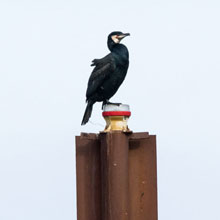
|
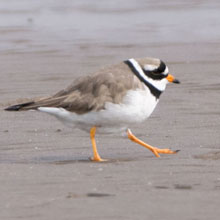
|
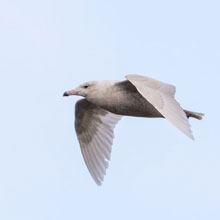
|
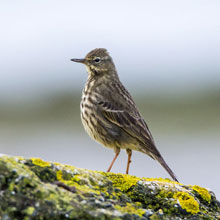
|
A 20 minute drive took me back
north to Doonfoot. At the mouth of the River Doon there were large
flocks of Gulls - Black-headed (the smallest ones), Lesser Black-backed
(yellow legs) and Great Black-backed (largest, pink legs and black
backs!). The missing members of the usual set of Gulls seen here are
the Common Gull (see above, medium-sized, Black-eyed) and Herring Gull
(large, grey back, pink legs). As I got out to the shoreline I noticed
four Whooper Swans a few metres out. They may have been taking a rest
on their way north to their summer homes (most likely Iceland).
Black - headed Gull
|
Lesser Black - backed Gull
|
Greater Black - backed Gull
|
Whooper Swan
|
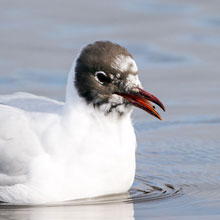
|
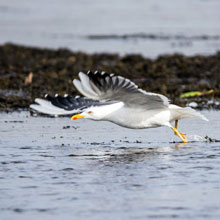
|
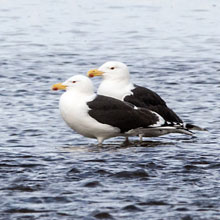
|
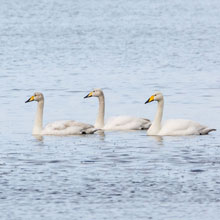
|
As the light worsened I also
spotted a Redshank and Greenshank feeding in the shallows before
getting too close and putting them up. Elsewhere on the sands there
were quite a few Carrion Crows scavenging where and whatever they
could. I had a look for birds at the pond by the car park but it was
deserted. I did though find some nice patches of the early-flowering
Coltsfoot.
Redshank
|
Greenshank
|
Carrion Crow
|
Coltsfoot
|
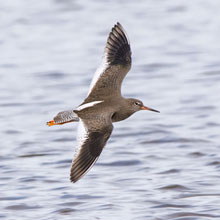
|
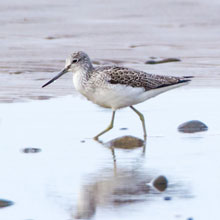
|
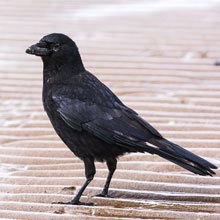
|
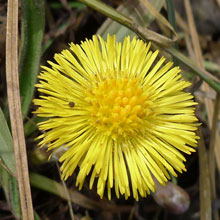
|
A short drive the took me to
Greenan Shore car park. On the way I noticed a lively flock of House
Sparrows on tall clumps of Broom on the edges of the large grass verge.
I walked by the hedges that line the dunes approaching Greenan Castle.
A Rabbit nipped under the hedge as I approached but I managed a sneaky
shot as its head was lit by the sun during an all too brief sunny
spell. A Stonechat darted from the same hedge onto a high stem of
vegetation in the adjacent field. It too was well lit by the sun. All
this time I was hearing the beautiful sound of an unseen Song Thrush
just ahead of me. I slowly and quietly tip-toed along the path until it
came into view some four metres from my camera, a Nikon D1500 with
Sigma 600mm zoom lens. It was so wrapped up in its serenade that I was
able to bag several shots before it noticed me.
House Sparrow
|
Rabbit
|
Stonechat
|
Song Thrush
|
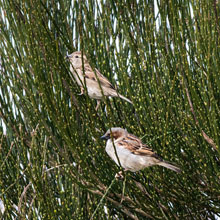
|
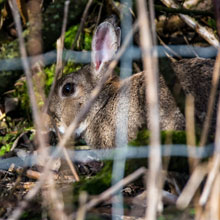
|
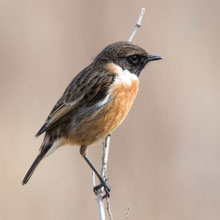
|
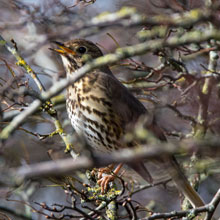
|
As I picked my way through the
hedges and dunes onto the shore I came upon a large patch of blooming
Snowdrops, another Spring flower. Below the Castle, Rock Pipits
were courting, the males ascending 10 metres into the air and the
gliding to the ground as they sang steady tones. As I photographed one
of the Pipits, a Robin appeared, inviting me to photograph it - I duly
obliged. Next I scrambled up the hill to the Castle with its
inspiring view.
Directly inland from the castle
there’s a rough path running along the edge of an overgrown field. I
thought I might get some sightings along the trees and hedges beside
the path. First up was a Rabbit sitting below a Goldfinch-laden tree.
As I sat on my stool snapping these, a bonny wee Blue Tit paid me a
brief visit, but long enough for a few shots. I made my way down to the
beach again to walk back to the car, treated to a fine sunlit panorama
of Ayr, with a paddling horse and rider in the foreground.
Rabbit
|
Goldfinch
|
Blue Tit
|
Ayr
|
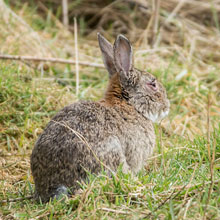
|
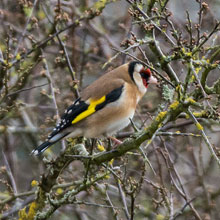
|
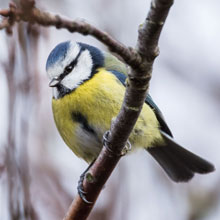
|
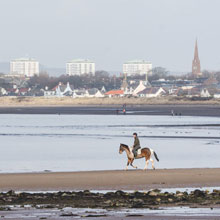
|
After a quick cuppa beside the
car, I realised it was now wall-to-wall sunshine and I was about to go
home. I resolved to go down to the seashore for an additional half hour
to see what was about. Straight away I came across a Curlew picking its
way across the rocky shore. As I edged closer, a pair of waders came
into view - a Redshank and Greenshank -maybe those I’d seen earlier,
but now in brilliant sunlight. I took lots of shots of the perfectly
lit pair. Eventually they flew off and I turned to go back to the car
and was face with a backlit view of Greenan Castle - very atmospheric.
The trip had got off to a slow
dull start but finished with a sunny flurry of shots. Highlights of the
trip are shown below, the Glaucous Gull being my favourite, closely
followed by the Greenshank. With a bit of good fortune perhaps John
will manage next week and I’ll get back to pastries with my tea!
( Yes. Back next week for sure. Finished nursing ill wife . Strange how
you can tell when they are getting better!!!! Ed)
Pictures Of The Week
1st Cycle Glaucous Gull
|
Ringed Plover
|
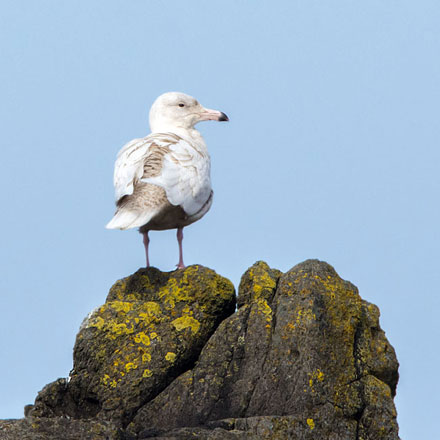
|
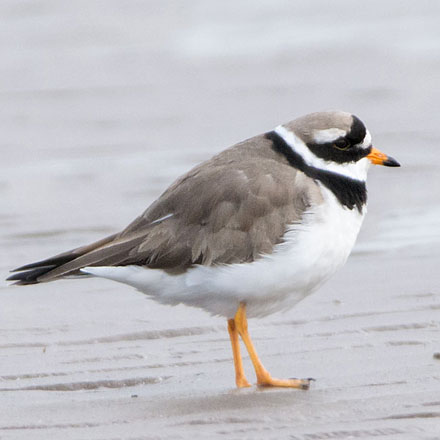
|
Song Thrush
|
Greenshank
|
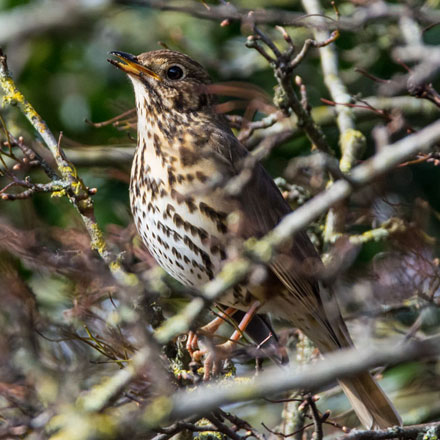
|
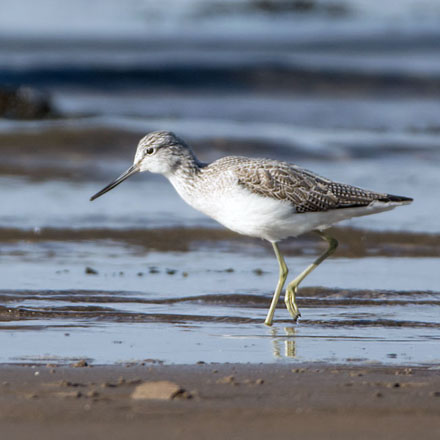
|
4th March 2018
Strathclyde Park
When I dragged myself from bed on
Sunday and peered out of the window I was disappointed with the dull,
grey scene before me. The weather forecast for the whole of Central
Scotland predicted a gloomy day ahead. No rain, but light levels were
to be poor. So with this in mind I decided to go to Strathclyde Park,
which is very close to my home. As I got into the car a cheery wee
House Sparrow greeted me, as it often does, from the top of its
favourite hedge. John was unable to join me but I still managed a
customary breakfast, this time in Morrisons at The Fort (8/10) before
driving to the Sports Pavilion at Strathclyde Park, Motherwell. I set
off on a trek around part of the Park, more in hope than expectation of
getting decent pictures, or even of seeing birds. A pair of
Black-headed Gulls drew were first to draw my attention. The adult’s
plumage was starting to show how they got their name. The plumage of
the younger bird, in its first cycle, showed patches of brown juvenile
feathers, an orange black-tipped bill and orange legs. Next I came upon
a few very active and noisy Jackdaws squabbling over scraps of
something.
House Sparrow
|
Black - headed Gull
|
1st Cycle Black - headed Gull |
Jackdaw
|
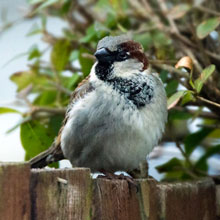
|
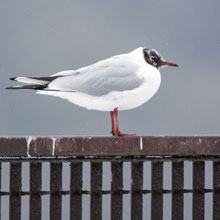
|
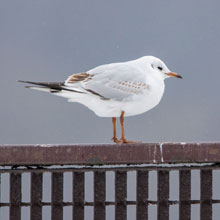
|
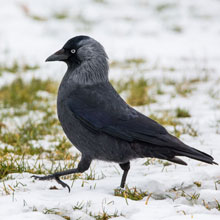
|
Watching the Jackdaws, a rough-looking, part leucistic Carrion Crow was
waiting on its moment to pinch their nibble. All this was interrupted by a pair
of incoming Greylag Geese which landed (see “Pictures of the Week” below),
noisily honking, and continued honking aggressively at the already assembled
flock of geese. These included a Greylag/Swan Goose hybrid and a Greylag/Canada
Goose hybrid. As I snapped some pictures of these, a wee bedraggled male Pied
Wagtail tweeted in close to where I was standing.
Carrion Crow
|
Greylag Goose
|
Greylag / Canada Hybrid
|
Pied Wagtail
|
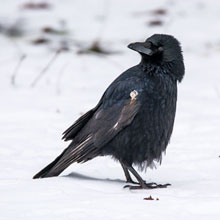
|
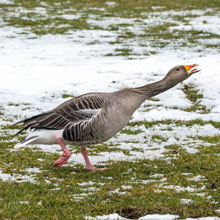
|
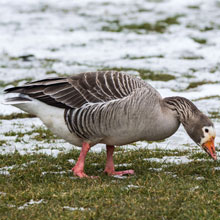
|
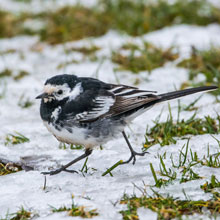
|
On the Loch, a pair of Tufted Duck
were diving for food, preferring molluscs, aquatic insects and some
plants. A Grey Wagtail flitted past and I followed it into one of the
Car Parks where I managed a few decent shots. It was starting to show
its breeding plumage as Spring approaches. I then decided to take the
footbridge over the River Clyde into the Hamilton part of Strathclyde
Park. I knew of areas there where I might get some passerines (perching
birds). As I crossed the bridge I spotted Little Grebes diving for
small fish at the water’s edge, before spotting me and backing off with
some haste.
DrakeTufted Duck
|
Female Tufted Duck
|
Grey Wagtail
|
Little Grebe
|
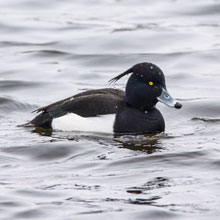
|
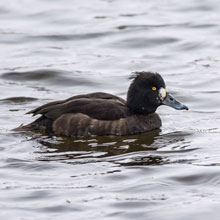
|
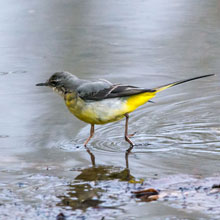
|
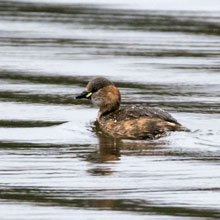
|
As I walked around the paths that
criss-cross the playing fields I saw a Fieldfare moving cautiously
amongst leaf litter. I then came across a short flurry of birds around
the same spot - Blackbird, Long-tailed Tit and Blue Tit all appeared at
the same time. Luckily they hung about long enough for me to get a few
photographs.
Fieldfare
|
Female Blackbird
|
Long - tailed Tit
|
Blue Tit
|
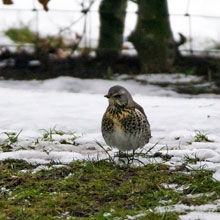
|
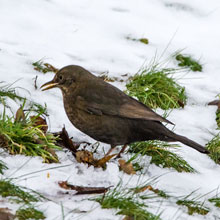
|
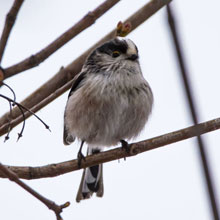
|
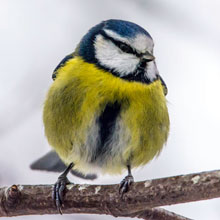
|
As I continued my walk, I was impressed by the grandeur of the Hamilton
Palace Mausoleum
that dominated the scene. It is sad that the Palace had to be demolished in
1927, due to subsidence caused by mine workings.
As I snapped a Robin, I began getting harassed by a wee cheeky, well-wrapped
dog, followed by his very apologetic owner. As the dog left the scene, a
familiar chatter of a Goldfinch led me to a nearby tree where I was able get a
clear line of sight to the bird and I managed a couple of shots.
Mausoleum
|
Robin
|
|
Goldfinch
|
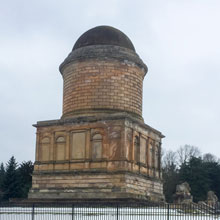
|
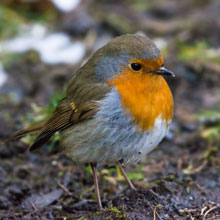
|
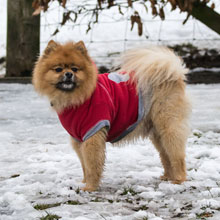
|
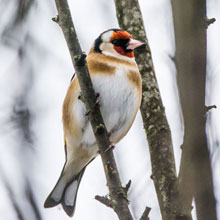
|
Making my way back to the
underpass that leads to the footbridge over the Clyde, I heard the
high-pitched trill of a Treecreeper. I located it after a few minutes
and was able to get a couple of shots. Back in at the Pavilion I took a
picture of a smart-looking Lesser Black-backed Gull, which has a
slightly darker grey back than the Herring Gull - and it has yellow
legs (rather than pink). Next I drove to the North Beach Car Park, as
the path from there to the dipping pond can yield some nice sightings.
Very quickly I discovered a flock of Redwings raking through leaf
litter below the trees just east of sandy beach. I spent a bit of time
there as the normally flighty Redwings were so hungry, some of them
completely ignored me. A bold Robin started trailing me as I was
trailing the Redwings.
Treecreeper
|
Lesser Black - backed Gull
|
Redwing
|
Robin
|
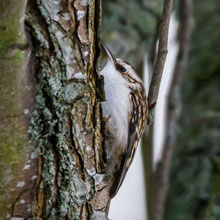
|
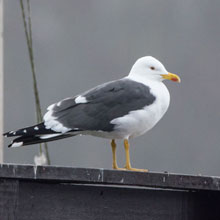
|
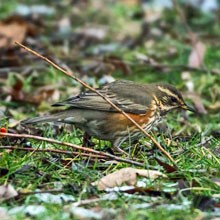
|
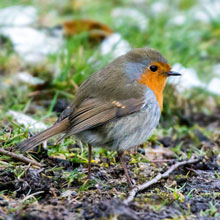
|
I reach the mouth of the South
Calder Water where a pair of Mute Swans were feeding. The male bird was
displaying its fine plumage to the seemingly disinterested female. As I
approached the footbridge across the river I spied a Mistle Thrush
sitting high in a tree. Its greyish-brown back and neatly round-spotted
underparts help distinguish it from the Song Thrush, which has rich
brown upper parts, pale buff underparts with dark speckles which look
like arrows pointing towards the head. I had a fruitless look for birds
around the so-called Roman Bridge (It seems it is probably a 17th
century structure). Close to the bridge there is a nicely excavated Roman Bathhouse
- which definitely is Roman and was designed to serve the Roman
soldiers that occupied the Roman Fort on the adjacent hill
(unfortunately the Fort is not as well excavated).
Along the last stretch approaching
the pond I photographed a Blackbird, a pair of Dunnocks and a couple of
Mallards. I nearly missed a pair of Bullfinches that were spooked by a
passing walker just as I pressed the shutter release (see “Pictures of
the Week” below). By that time, the light had got really poor and rain
was threatening, so I decided to call it a day…..
Blackbird
|
Dunnock
|
Goldeneye
|
Mallard
|
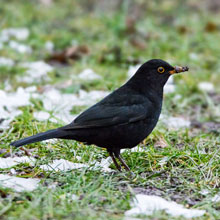
|
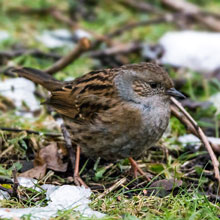
|
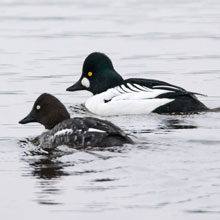
|
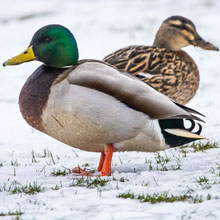
|
….but not before I had a wee cuppa
and a chocolate biscuit. So, as you’ll see from the above, I exceeded
my initial expectations and managed to observe a fair number of birds -
which goes to show that you should ignore your negative thoughts just
get on with it. It is a pity the sun didn’t show up as Strathclyde Park
is a wonderful place for observing nature. I will return (when it’s
sunny).
Pictures of the Week
Greylag Goose
|
Treecreeper
|
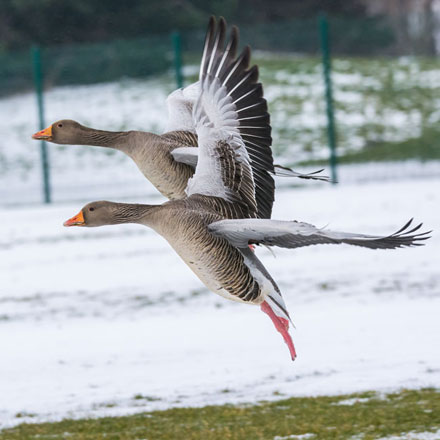
|
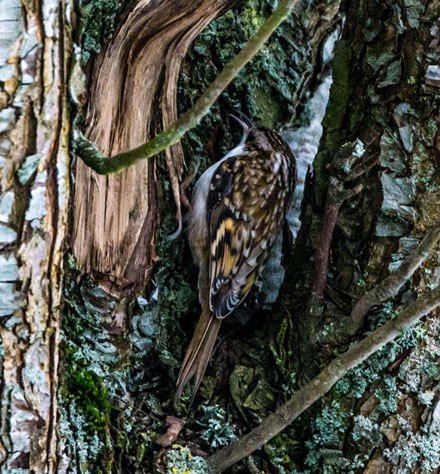
|
Bullfinch
|
Redwing
|
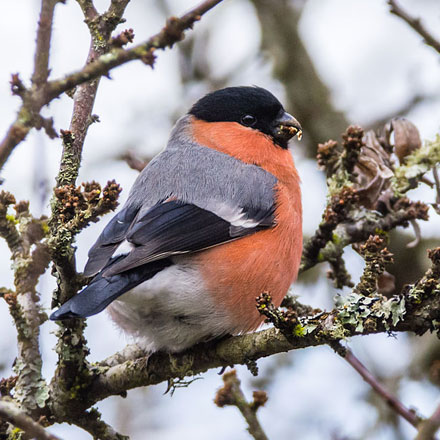
|
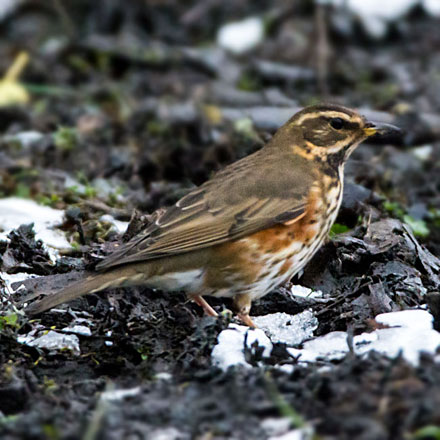
|
Back To Top
|

